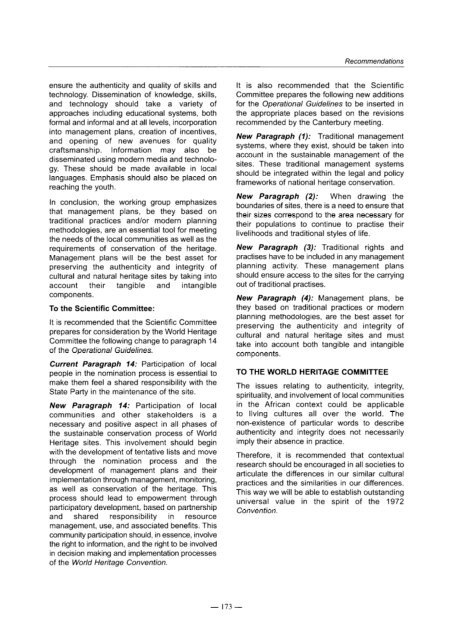Mul - unesdoc - Unesco
Mul - unesdoc - Unesco
Mul - unesdoc - Unesco
You also want an ePaper? Increase the reach of your titles
YUMPU automatically turns print PDFs into web optimized ePapers that Google loves.
ensure the authenticity and quality of skills and<br />
technology. Dissemination of knowledge, skills,<br />
and technology should take a variety of<br />
approaches including educational systems, both<br />
formal and informa1 and at all levels, incorporation<br />
into management plans, creation of incentives,<br />
and opening of new avenues for quality<br />
craftsmanship. Information may also be<br />
disseminated using modern media and technolo-<br />
gy. These should be made available in local<br />
languages. Emphasis should also be placed on<br />
reaching the youth.<br />
In conclusion, the working group emphasizes<br />
that management plans, be they based on<br />
traditional practices and/or modern planning<br />
methodologies, are an essential tool for meeting<br />
the needs of the local communities as well as the<br />
requirements of conservation of the heritage.<br />
Management plans Will be the best asset for<br />
preserving the authenticity and integrity of<br />
cultural and natural heritage sites by taking into<br />
account their tangible and intangible<br />
components.<br />
TO the Scientific Committee:<br />
It is recommended that the Scientific Committee<br />
prepares for consideration by the World Heritage<br />
Committee the following change to paragraph 14<br />
of the Operational Guidelines.<br />
Carrent Paragraph 74: Participation of local<br />
people in the nomination process is essential to<br />
make them feel a shared responsibility with the<br />
State Party in the maintenance of the site.<br />
New Paragraph 74: Participation of local<br />
communities and other stakeholders is a<br />
necessary and positive aspect in all phases of<br />
the sustainable conservation process of World<br />
Heritage sites. This involvement should begin<br />
with the development of tentative lists and move<br />
through the nomination process and the<br />
development of management plans and their<br />
implementation through management, monitoring,<br />
as well as conservation of the heritage. This<br />
process should lead to empowerment through<br />
participatory development, based on partnership<br />
and shared responsibility in resource<br />
management, use, and associated benefits. This<br />
community participation should, in essence, involve<br />
the right to information, and the right to be involved<br />
in decision making and implementation processes<br />
of the World Heritage Convention.<br />
- 173-<br />
Recommendations<br />
It is also recommended that the Scientific<br />
Committee prepares the following new additions<br />
for the Operational Guidelines to be inserted in<br />
the appropriate places based on the revisions<br />
recommended by the Canterbury meeting.<br />
New faragraph (7): Traditional management<br />
systems, where they exist, should be taken into<br />
account in the sustainable management of the<br />
sites. These traditional management systems<br />
should be integrated within the legal and policy<br />
frameworks of national heritage conservation.<br />
New Paragraph (2): When drawing the<br />
boundaries of sites, there is a need to ensure that<br />
their sizes correspond to the area necessary for<br />
their populations to continue to practise their<br />
livelihoods and traditional styles of life.<br />
New Paragraph (3): Traditional rights and<br />
practises have to be included in any management<br />
planning activity. These management plans<br />
should ensure access to the sites for the carrying<br />
out of traditional practises.<br />
New Paragraph (4): Management plans, be<br />
they based on traditional practices or modern<br />
planning methodologies, are the best asset for<br />
preserving the authenticity and integrity of<br />
cultural and natural heritage sites and must<br />
take into account both tangible and intangible<br />
components.<br />
TO THE WORLD HERITAGE COMMITTEE<br />
The issues relating to authenticity, integrity,<br />
spirituality, and involvement of local communities<br />
in the African context could be applicable<br />
to living cultures all over the world. The<br />
non-existence of particular words to describe<br />
authenticity and integrity does not necessarily<br />
imply their absence in practice.<br />
Therefore, it is recommended that contextual<br />
research should be encouraged in all societies to<br />
articulate the differences in our similar cultural<br />
practices and the similarities in our differences.<br />
This way we Will be able to establish outstanding<br />
universal value in the spirit of the 1972<br />
Convention.

















